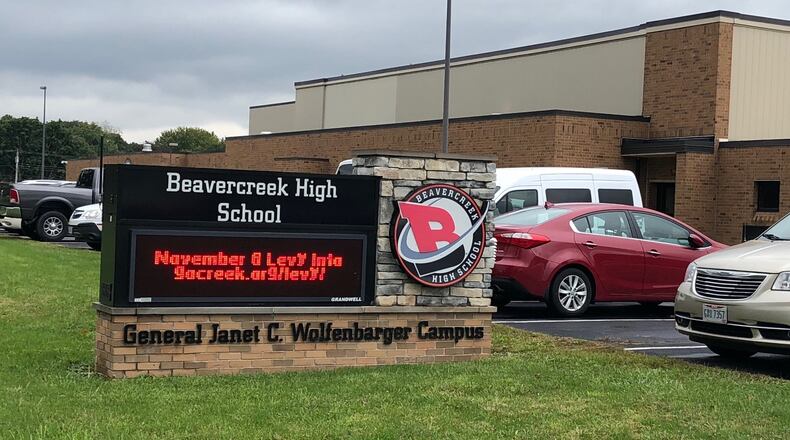This school year, as state rules changed, eligibility expanded to include a handful of suburban schools.
JANUARY: Private-school voucher program to double in 19-20
But for next fall, 30 of the 40 Dayton-area public school districts will have at least one school where students can get a publicly funded voucher to attend private school instead.
The state’s new list of those “underperforming public schools” includes Beavercreek High School, Weller Elementary in Centerville, Broadway Elementary and Tippecanoe Middle School in Tipp City, and Donovan Elementary in Lebanon.
Schools are placed on the EdChoice eligibility list if they fail to meet any of six performance markers tied to the state report card for schools. But some leaders say the criteria, and the report card that underpins them, may be the problem.
“You have high-performing schools that are getting dinged on EdChoice for low (student growth) scores because they can’t go any higher,” said Ohio Senate Education Committee Chair Peggy Lehner. “Solon, the top-scoring school district in the state, has a school that’s eligible for EdChoice. That’s crazy.”
2018 STORY: Task force tackles poverty’s impact on education
Solon’s Parkside Elementary near Cleveland is on the list of underperforming schools despite 97 percent of its students grading proficient or better on the state performance index, and 90 percent hitting the accelerated or advanced levels. Their raw performance index actually rose this year, but they fell from 4th of the state’s 3,300-plus public schools to 5th, and they got a “D” in student progress.
Students can leave Parkside and receive a state-paid voucher to attend private school.
Ohio Department of Education spokeswoman Mandy Minick confirmed there is no "verification of educational quality" required of the private schools who accept EdChoice students. Those schools must comply with a series of state operating standards, but none reference academic performance.
"ODE is required to post annually an aggregation of scholarship student (test) results," Minick said. "As a parental choice program, parents are able to use these results to compare their chosen private school to their child's assigned public school."
To see traditional public schools' test results in a comparable format, parents would have to construct an Advanced Reports search on the ODE website, making the comparison difficult.
Last year, Mad River schools Superintendent Chad Wyen questioned the use of test scores as any type of EdChoice eligibility standard when his Stebbins High School was put on the list. He pointed to Stebbins’ career tech options, state STEM school designation and bevy of College Credit Plus choices as the type of opportunities the state should want for students.
SCHOOLS: Student religious liberty bill passes Ohio House
The majority of students who use private-school vouchers locally attend Catholic schools. Jennifer Schack, spokeswoman for the Archdiocese of Cincinnati, said Catholic school voucher enrollment in the Dayton and Springfield area actually declined by 1.4 percent this school year, mirroring a similar decline in total enrollment.
Schack said each individual Catholic school determines its enrollment and admission policies, making general answers about the impact of Ohio’s EdChoice changes difficult.
“The EdChoice programs have benefited both the schools and the students who take advantage of these state funded programs,” Schack said. “Schools do their very best to best serve the students given the resources that are available.”
Among the local public schools designated as underperforming is Lebanon’s Donovan Elementary, which had no grade below a “C” on the most recent state report card, including an “A” in student progress. Cedarville Elementary is on the list even though 81.5 percent of its students graded proficient or better last year and every student met Ohio’s third-grade reading standard.
The new “underperforming” list goes on, including Dayton’s Horace Mann, with A’s in both student progress and gap closing, and Newton High School in Miami County, which had a 100% five-year graduation rate.
RELATED: Ohio seeks to reinvent the high school experience
Lehner said part of the problem is that the state uses three years of report card data to determine “underperforming schools,” but those three years are 2018-19, 17-18 and 13-14, because schools were given “safe harbor” for the three years in between, when Ohio was changing state tests.
“I think we have to look at the eligibility,” Lehner said, adding that she had gotten conflicting answers from different people at ODE. “There are several things that are problematic.”
The voucher amount is currently $4,650 per year for students in grades K-8 — fully covering tuition at many schools — and $6,000 for high school students, leaving $3,000-plus uncovered at most non-public high schools.
The number of individual schools where students are eligible to leave via voucher rose from 255 to 487 this year, and will skyrocket to 1,233 next fall – more than one-third of all Ohio public schools. The number of districts with at least one affected school rose from 32 to 137 this year, and will soar to 426 of Ohio’s 610 districts next year.
ODE said Tuesday that 30,106 students are using traditional EdChoice vouchers tied to underperforming schools — a 30 percent increase from last year. Another 12,312 are in the state’s voucher program for low-income families, a 15 percent rise from last year.
Vandalia-Butler schools Superintendent Rob O’Leary questioned why his district’s Demmitt Elementary and Morton Middle School are on the voucher-eligible list. Both schools had more than 70 percent of students proficient on state tests.
RELATED: Sponsors of local charter schools get strong ratings
“We feel some faulty data from the way the report card is set up feeds this list,” O’Leary said. “Some reform absolutely has to happen at the report card level.”
A state study group is preparing recommendations to change the report card system, but Lehner said the EdChoice issue leads to financial concerns too, at a time when a separate private-school voucher program for low-income students was just approved for a $50 million expansion.
“I’m told 85 percent of kids at Carroll High School will be eligible for EdChoice scholarships,” Lehner said. “The parents could be millionaires, and the state is going to be picking up the majority of the tuition at Carroll.”
Schack argued that EdChoice vouchers have given many families a chance at faith-based education in small schools that offer benefits beyond the academic offerings, including moral education.
“Among the many important jobs that parents have is the education of their child,” she said. “They should be able to choose the education that will match their value system.”
Voucher-eligible schools for 2020-21
MONTGOMERY COUNTY
Centerville — Weller ES
Dayton — Belle Haven ES, Charity Earley ES, Cleveland ES, Eastmont ES, Edison ES, Fairview ES, Horace Mann ES, Kemp ES, Kiser ES, Louise Troy ES, River’s Edge Montessori ES, Ruskin ES, Valerie ES, Westwood ES, World of Wonder ES, EJ Brown MS, Wogaman MS, Wright Brothers MS, Belmont HS, Ponitz CTC, Dunbar HS, Meadowdale HS, Thurgood Marshall HS, Dayton Digital Academy
Huber Heights — Weisenborn JH, Wayne HS
Jefferson Township — Blairwood ES, Jefferson HS
Mad River Local — Brantwood ES, Stevenson ES, Mad River MS, Spinning Hills MS, Stebbins HS,
Miamisburg — Bauer ES, Kinder ES, Mark Twain ES, Mound ES
New Lebanon — Dixie ES
Northmont — Northwood ES, Union ES
Northridge – Morrison ES, Esther Dennis MS, Northridge HS
Trotwood-Madison — Trotwood-Madison Early Learning Center, Madison Park ES, Westbrooke Village ES, Trotwood-Madison MS, Trotwood-Madison HS
Vandalia-Butler — Demmitt ES, Morton MS
West Carrollton — West Carrollton MS, West Carrollton HS
NO ELIGIBLE SCHOOLS – Brookville, Kettering, Oakwood, Valley View
GREENE COUNTY
Beavercreek – Beavercreek HS
Cedar Cliff – Cedarville ES
Fairborn – Fairborn Primary ES, Baker MS, Fairborn HS
Greeneview – Greeneview MS, Greeneview HS
Xenia – Cox ES, McKinley ES, Shawnee ES, Warner MS, Xenia HS
Yellow Springs – Mills Lawn ES
NO ELIGIBLE SCHOOLS – Bellbrook
MIAMI COUNTY
Bradford – Bradford ES, Bradford HS
Covington – Covington ES, Covington JH, Covington HS
Milton-Union – Milton-Union ES, Milton-Union HS
Newton – Newton HS
Piqua – Springcreek ES, Washington ES, Piqua HS
Tipp City – Broadway ES, Tippecanoe MS
Troy – Cookson ES, Forest ES, Heywood ES
NO ELIGIBLE SCHOOLS – Bethel, Miami East
NORTHERN WARREN COUNTY
Carlisle – Grigsby Intermediate
Franklin – Wayne ES, Gerke ES, Schenck ES, Pennyroyal ES, Franklin JH
Lebanon – Donovan ES, Lebanon JH, Lebanon HS
NO ELIGIBLE SCHOOLS – Springboro, Wayne Local
OTHERS
Tecumseh – Donnelsville ES, Tecumseh MS, Tecumseh HS
Greenon – Indian Valley Intermediate, Greenon JH, Greenon HS
NO ELIGIBLE SCHOOLS — Eaton
NOTE: ES = Elementary school; MS = Middle school; JH = Junior high; HS = High school
SOURCE: Ohio Department of Education
About the Author

